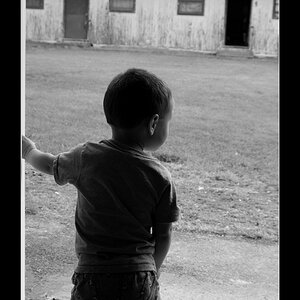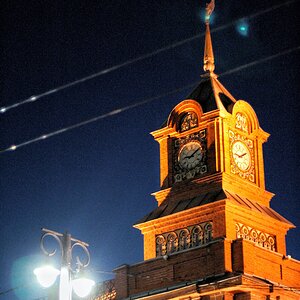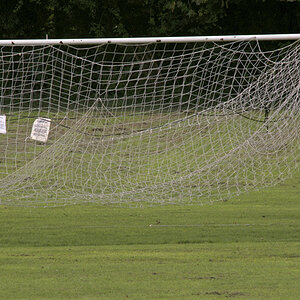Derrel
Mr. Rain Cloud
- Joined
- Jul 23, 2009
- Messages
- 48,225
- Reaction score
- 18,941
- Location
- USA
- Website
- www.pbase.com
- Can others edit my Photos
- Photos OK to edit
Well, the DXO Mark system explains their system exceedingly well.
DxOMark metrics
1>Resolution>SNIP>
2>.SNIP> So before comparing cameras with DxOMark Sensor, it is important to first determine the resolution you are looking for (which largely depends on the size of the screen or the print you intend to use or produce). Once you choose an appropriate resolution, the DxOMark Sensor scale becomes a fair and powerful tool with which to make comparisons."
UH--Reichmann MISSED that point in his article. He whiffed,and missed. Strike One.
3."DxOMark Sensor scale is based on three photographic usagesStudio, Landscape, and Action photography. The three scenarios are equally weighted in the DxOMark Sensor scale results. If photographers are more inclined towards a specific scenario, they should look at the individual metric that best meets their needsi.e., Studio photographers should primarily consider Color Depth and Dynamic range, Landscape photographers should primarily consider Dynamic Range and Color Depth, and Action photographers/Photojournalists should pay most attention to Low-Light ISO and Dynamic Range."
**Strikes two and three for Reichmann's article. He failed to understand the rules of the game, entirely.
I read the Michael Reichmann L-L article quite some time ago. Nice essay he wrote, but flawed in light of the specific, clear instructions on HOW to USE the data properly. He says he "Sees things" he cannot agree with coming from scientific tests? Have a look at this:
diglloyd: Infrared Contamination
and then read what those keen Recihmann eyes saw in the Leica M8 Review under the Image Quality section:
Leica M8 Review
"The point that I wish to make though is that the new M8 is as adept as any film-based Leica in capturing that hard-to-pin-down Leica lens goodness. This had been my major anticipated concern with the M8 in between seeing it at Photokina and when the production test sample arrived at my door. Would it do justice to the best of Leica's lens family? It didn't take more than a handful of prints to see that my apprehension was unfounded. And, when a photographer friend who has an extremely critical eye, and who is a long-time M series user came over and viewed my initial batch of prints, the first words out of his mouth were "These are simply Leica photographs. You can see right through to the lens quality. There's nothing at all digital about the look. ".
"I agree. In terms of being transparent to what the lenses used can deliver, I found it hard to find any performance aspect wanting. The smooth large-field tonalities, coupled with the bitingly sharp microcontrasts that are both hallmarks of Leica images, are all there. As for colour rendering, that's harder to report on because a raw file is capable of so many interpretation. Certainly the wide gamut reported on elsewhere in this review shows a very rich palette to be available. I did find on more than one occasion that colour saturation was higher than I expected, or am used to. This may well be a profile issue rather than anything else, and I expect it to become sorted out before long. My friend Nick Devlin, a long-time Leica photographer, called it Leicachrome. An apt name. Nothing that a bit of tweaking with the saturation control can't deal with though."
WOW---the Leica M8, the camera with the absolutely horrible,horrible Magenta Cast issue that caused Leica such humiliation...somehow, Reichmann's super eyes missed the fact that almost anything black appeared to have a magenta cast. And he says the DXO Mark data is somehow untrustworthy?
DxOMark metrics
1>Resolution>SNIP>
2>.SNIP> So before comparing cameras with DxOMark Sensor, it is important to first determine the resolution you are looking for (which largely depends on the size of the screen or the print you intend to use or produce). Once you choose an appropriate resolution, the DxOMark Sensor scale becomes a fair and powerful tool with which to make comparisons."
UH--Reichmann MISSED that point in his article. He whiffed,and missed. Strike One.
3."DxOMark Sensor scale is based on three photographic usagesStudio, Landscape, and Action photography. The three scenarios are equally weighted in the DxOMark Sensor scale results. If photographers are more inclined towards a specific scenario, they should look at the individual metric that best meets their needsi.e., Studio photographers should primarily consider Color Depth and Dynamic range, Landscape photographers should primarily consider Dynamic Range and Color Depth, and Action photographers/Photojournalists should pay most attention to Low-Light ISO and Dynamic Range."
**Strikes two and three for Reichmann's article. He failed to understand the rules of the game, entirely.
I read the Michael Reichmann L-L article quite some time ago. Nice essay he wrote, but flawed in light of the specific, clear instructions on HOW to USE the data properly. He says he "Sees things" he cannot agree with coming from scientific tests? Have a look at this:
diglloyd: Infrared Contamination
and then read what those keen Recihmann eyes saw in the Leica M8 Review under the Image Quality section:
Leica M8 Review
"The point that I wish to make though is that the new M8 is as adept as any film-based Leica in capturing that hard-to-pin-down Leica lens goodness. This had been my major anticipated concern with the M8 in between seeing it at Photokina and when the production test sample arrived at my door. Would it do justice to the best of Leica's lens family? It didn't take more than a handful of prints to see that my apprehension was unfounded. And, when a photographer friend who has an extremely critical eye, and who is a long-time M series user came over and viewed my initial batch of prints, the first words out of his mouth were "These are simply Leica photographs. You can see right through to the lens quality. There's nothing at all digital about the look. ".
"I agree. In terms of being transparent to what the lenses used can deliver, I found it hard to find any performance aspect wanting. The smooth large-field tonalities, coupled with the bitingly sharp microcontrasts that are both hallmarks of Leica images, are all there. As for colour rendering, that's harder to report on because a raw file is capable of so many interpretation. Certainly the wide gamut reported on elsewhere in this review shows a very rich palette to be available. I did find on more than one occasion that colour saturation was higher than I expected, or am used to. This may well be a profile issue rather than anything else, and I expect it to become sorted out before long. My friend Nick Devlin, a long-time Leica photographer, called it Leicachrome. An apt name. Nothing that a bit of tweaking with the saturation control can't deal with though."
WOW---the Leica M8, the camera with the absolutely horrible,horrible Magenta Cast issue that caused Leica such humiliation...somehow, Reichmann's super eyes missed the fact that almost anything black appeared to have a magenta cast. And he says the DXO Mark data is somehow untrustworthy?






![[No title]](/data/xfmg/thumbnail/32/32155-5dfb2c8aee58498ba1862d4f34389669.jpg?1619735234)






